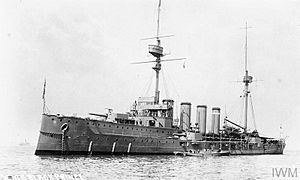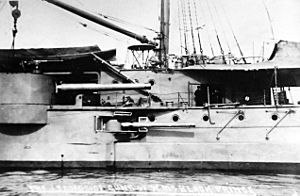HMS Black Prince (1904) facts for kids

Black Prince
|
|
Quick facts for kids History |
|
|---|---|
| Name | Black Prince |
| Namesake | Edward, the Black Prince |
| Builder | Thames Ironworks |
| Laid down | 3 June 1903 |
| Launched | 8 November 1904 |
| Commissioned | 17 March 1906 |
| Fate | Sunk, 1 June 1916 at the Battle of Jutland |
| General characteristics | |
| Class and type | Duke of Edinburgh-class armoured cruiser |
| Displacement |
|
| Length | 505 ft 6 in (154.1 m) |
| Beam | 73 ft 6 in (22.4 m) |
| Draught | 27 ft (8.2 m) (maximum) |
| Installed power | 23,000 ihp (17,000 kW) |
| Propulsion |
|
| Speed | 23 knots (43 km/h; 26 mph) |
| Range | 8,130 nmi (15,060 km; 9,360 mi) at 10 knots (19 km/h; 12 mph) |
| Complement | 789 |
| Armament |
|
| Armour |
|
HMS Black Prince was a type of warship called an armoured cruiser. She was built for the Royal Navy (Britain's navy) in the early 1900s. When World War I started, she was in the Mediterranean Sea.
Black Prince helped chase two German warships, the battlecruiser Goeben and the light cruiser Breslau. After these German ships reached neutral Ottoman waters, Black Prince was sent to the Red Sea. Her job there was to protect ships carrying troops from India and to look for German merchant ships. She successfully captured two German ships. In December 1914, Black Prince joined the main British fleet, called the Grand Fleet. Sadly, she was sunk on June 1, 1916, during the huge naval battle known as the Battle of Jutland. All the sailors on board were lost.
Contents
Building and Features of HMS Black Prince
The Black Prince was one of two new armoured cruisers ordered for the Royal Navy. These ships were much bigger than older cruisers. They also carried heavier main guns. The ship was named after Edward, the Black Prince, a famous English prince from history.
Black Prince was a large ship. She weighed about 12,590 tons when built. She was about 154 meters (505 feet) long and 22 meters (73 feet) wide. Her engines were powerful, producing 23,000 horsepower. This allowed her to reach a top speed of 23 knots (about 43 kilometers per hour). She could travel about 8,130 nautical miles (15,000 km) at a slower speed of 10 knots. The ship had a crew of 789 officers and sailors.
Her main weapons were six large 9.2-inch guns. These were placed in single turrets. She also had ten 6-inch guns for secondary attacks. For closer combat, she carried twenty smaller 3-pounder guns. The ship also had three torpedo tubes that fired torpedoes from underwater. Black Prince was protected by thick armor on her sides, decks, and gun turrets.
Black Prince in Action
Black Prince was built at the Thames Ironworks and Shipbuilding Company in London. Her construction started on June 3, 1903. She was launched into the water on November 8, 1904, and finished on March 17, 1906.
After she was completed, Black Prince served in different squadrons (groups of ships) of the Royal Navy. When World War I began, she was part of the 1st Cruiser Squadron in the Mediterranean Fleet. She helped chase the German ships Goeben and Breslau.
After the German ships escaped, Black Prince went to the Red Sea. There, she found and captured two German merchant ships, the Südmark and the Istria. In December 1914, Black Prince joined the main British fleet, the Grand Fleet. She was assigned to the 1st Cruiser Squadron again.
In March 1916, Black Prince was changed a bit. Some of her 6-inch guns were moved to new positions. This was done because of lessons learned from earlier battles.
The Loss of Black Prince
Black Prince took part in the Battle of Jutland, a huge naval battle in World War I. Sadly, she was sunk during this battle, and her entire crew was lost. For some years, people weren't sure exactly how she sank.
During the battle, Black Prince was part of a group of ships scouting ahead of the main British fleet. She lost contact with her squadron around 5:42 PM. Later, two other ships from her squadron, Defence and Warrior, were heavily attacked by German battleships. Defence exploded, and Warrior was badly damaged and later sank.
The British fleet didn't see Black Prince again after she lost contact. However, a radio message from her was received at 8:45 PM, reporting a submarine sighting. Later that night, a British destroyer called Spitfire saw a burning ship. It was described as "a mass of fire from foremast to mainmast." This burning ship exploded around midnight. At first, some thought this might have been Black Prince.
However, later historians agree with the German accounts of how Black Prince sank. Black Prince briefly fought the German battleship Rheinland around 11:35 PM. She hit Rheinland twice with her 6-inch guns.
After midnight, Black Prince accidentally sailed too close to the German battle line. She tried to turn away, but it was too late. The German battleship Thüringen lit up Black Prince with its searchlights and opened fire. Up to five other German battleships, including Nassau and Ostfriesland, also joined in the attack. Black Prince's return fire was not effective.
Most of the German ships were very close to Black Prince, only about 750 to 1,500 yards away. This was almost point-blank range for naval guns. Black Prince was hit by at least twelve large shells and many smaller ones. She sank within 15 minutes. All 857 sailors on board were killed.
The place where Black Prince sank is now a protected site under the Protection of Military Remains Act 1986.
Images for kids



